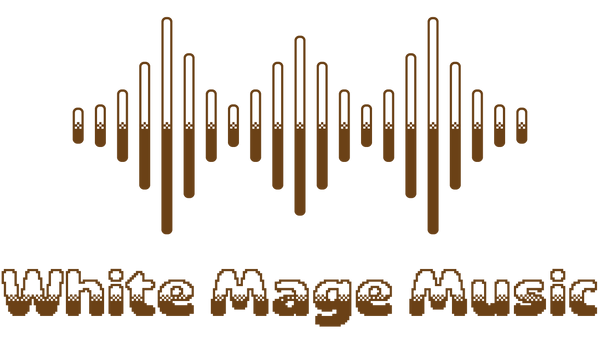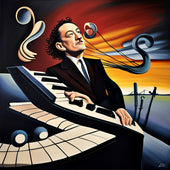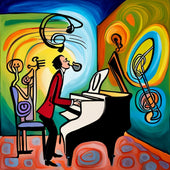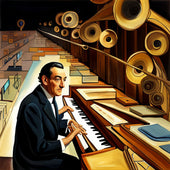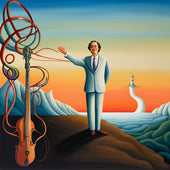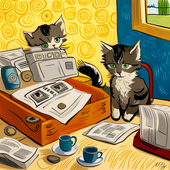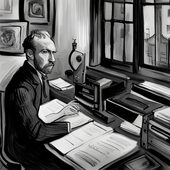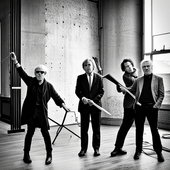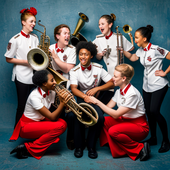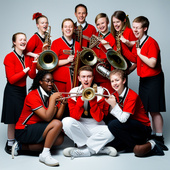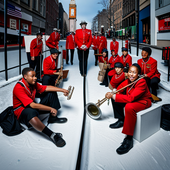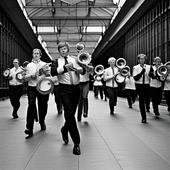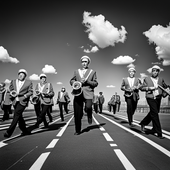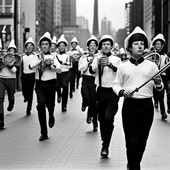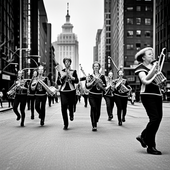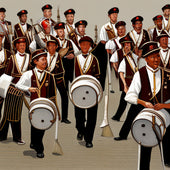In another post, I discussed the importance of creating a schedule for your marching rehearsal, reflecting on how rehearsals that are very loose and "shooting from the hip" aren't an effective use of your students' or staff's time.
A second common issue I've seen going to rehearsals is an ill-structured rehearsal process. Like many things, there are many right ways to do it, but there are also a bunch of incorrect ways.
Before we even get to the flow, there are two imperatives that will keep your rehearsals tight, efficient, and effective.
Second, another detail of the standby position - but just general, across the whole rehearsal, the members should be quiet. Their silence allows them to receive instruction more effectively and it keeps the field calm. Calm on the field will save you reps with missed directions and it will keep all the performers' minds more engaged on the rehearsal.
1. Starting the Rep.
Your drum major should start every rep, including giving the directions. Your voice, from the box/tower, is the voice of instruction and feedback. By having your drum major give the new directions, the attention of everyone on the field will be redirected and focused.
The drum major starts by giving (even if redundant) "Standby." This is a nod to your field staff that the next thing is about to happen and they should be rapping up their feedback. It calls the attention of all the performers to the drum major. When that leader calls out "standby," all eyes should be on them, understanding more information is about to come.
Next, the drum major gives the necessary directions for the rep. "Letter A to Letter B." "Page 21 to Page 29." "Air and valve." Whatever your directions are - your drum major should be the one to give that information, and in a thorough enough manner that all performers know what is expected of them.
After giving the directions, your drum major calls "Set." At this point, your members go to the position necessary to start the rep (instruments/equipment up, minus-one in the feet, etc.)
Upon going to "set," have the members repeat the directions back, in some way. My preference is to simply reiterate the stopping point. "Letter B." "Page 29." By having them reiterate only the one part of the direction, that shows they've had to listen, process, and engage with the detail.
Once the band is set, your drum major cues the metronome to begin (Yes, you should be using a metronome OFTEN!) - and after your standard prep (I prefer 8-and-go all the time), the rep begins.
2. Finishing the Rep.
Once the performers reach the stopping point in the rep, the drum major holds out the "plus one," and the cuts the band off. The instruments/equipment remain in playing (performing) position.
Next, the drum major gives "Check." This is a cue to the members to use their eyes only to scan the form and the field in order to assess if they've arrived to the correction position. This step is ONLY to look.
After "check," the drum major calls out "Adjust." At this point, the performers make the adjustment to their position, moving to where they should be.
[A note: one the flow of rehearsals is pretty well understood and your performers are more confident in their job, "Adjust" usually follows "Check" after a very short pause - no more than a second or two.]
Following "adjust," the drum major calls out "Standby." The performers return to the standby position, upper bodies relaxed (to allow muscle recovery, especially for larger instruments), and most importantly - calm and quiet.
Returning to STANDBY before feedback comes is a major facet in a rehearsal running smoothly and effectively. When the students are standing with the instruments in playing position while they're not moving and playing, their attention turns 100% to their body being sore and uncomfortable. No amount of philosophic conversation over "controlling mind over matter" or whatnot will change the fact that the students are going to ignore almost all of your information because they're uncomfortable. You'll simply end up wasting reps.
3. Providing Feedback.
The hardest part for any staff member is to remain calm until the drum major has completed "Check-Adjust-Standby." But I can't stress how important it is. Allow the process to finish. Allow for an organized flow of information. When the staff adheres to the rehearsal process and remains quiet and calm, it will be a model for the performers that they, too, should remain quiet and calm on the field.
The feedback part of rehearsal starts to rely on the art of the teaching. However information needs to go, always go "top-down." The box talks first. The field staff waits until their opportunity and then provides commentary.
Perhaps some reps need substantial upstairs feedback - big picture, Ensemble comments. Even here, keep it limited. Don't give any one student more than two (MAYBE three) bits of information to remember for the next rep. If one instructor has a lot to offer, it's going to save time for the next staff member to just wait for the next rep.
There are also plenty of reps when the box doesn't need to talk. Allow your field staff to provide comments to individual performers. Field comments also fall into the consideration of how much detail one performer has received. If the box gave your section two pretty important considerations for the next rep, just hold your comments until another time. Your performers aren't going to catch everything.
Some of the roughest rehearsals I've been to are when the director, upstairs in the box/tower, gives a running commentary throughout all of the downtime in a rehearsal: feedback for sections, feedback for individuals, and then the worst: unrelated chatter. This just creates noise on the field that detracts from efficacy. It's a cue for the students on the field that it's also okay for them to participate in unrelated smalltalk.
One of the most challenging situations for feedback: the last rep. If you're not going to be resetting to perform the rep again, just hold off on giving feedback. You're likely looking at not hitting that phrase until probably a completely different rehearsal. Your performers aren't going to remember any kind of detailed feedback, unless there is some major cause for concern.
4. After Feedback.
My personal preference, once the feedback has ended, is for the drum major to be the one to call "Reset." For one, this keeps the drum major engaged in all the information flowing. Two, it again keeps their voice as that which gives directions on the field.
It doesn't always happen this way - often I even slip up and will call the Reset on my own.
My personal style & flow
If I'm running the rehearsal, I'll go through the similar process above. The drum major kicks off the rep. At the end, they give "check-adjust-standby." Then I'll give any comments I might have from up top. After I give two to three effective and succinct comments (hitting different sections with each), I'll call out "Field" to cue the field staff that it's their turn to give feedback.
During the "Field" time, I'll get the drum major's attention and provide them with the next instruction. They'll learn to read the field and then call out "reset" or "standby" to get the next directions out. This is an efficient way to use time: during field feedback, both yourself and the drum major aren't engaged with the students on the field, so you can cover your next step.
One last note: Reps versus Feedback.
We've all been in a practice room, working through a lick, and totally whiffed it. We know the difference between "I need to break this down," and "I just need to give it another whack."
Your band is no different. There will be some reps that aren't very successful.
Especially in the early stages of the learning process, there will frequently be times that the performers don't need more words from you or your staff - they simply just need to give it another go. Fight the urge to always talk - let the students take another shot at it. There's a high likelihood they're going to figure more things out by simply running back and doing it again, relying on their short-term memory to get them through the next rep more successfully.
